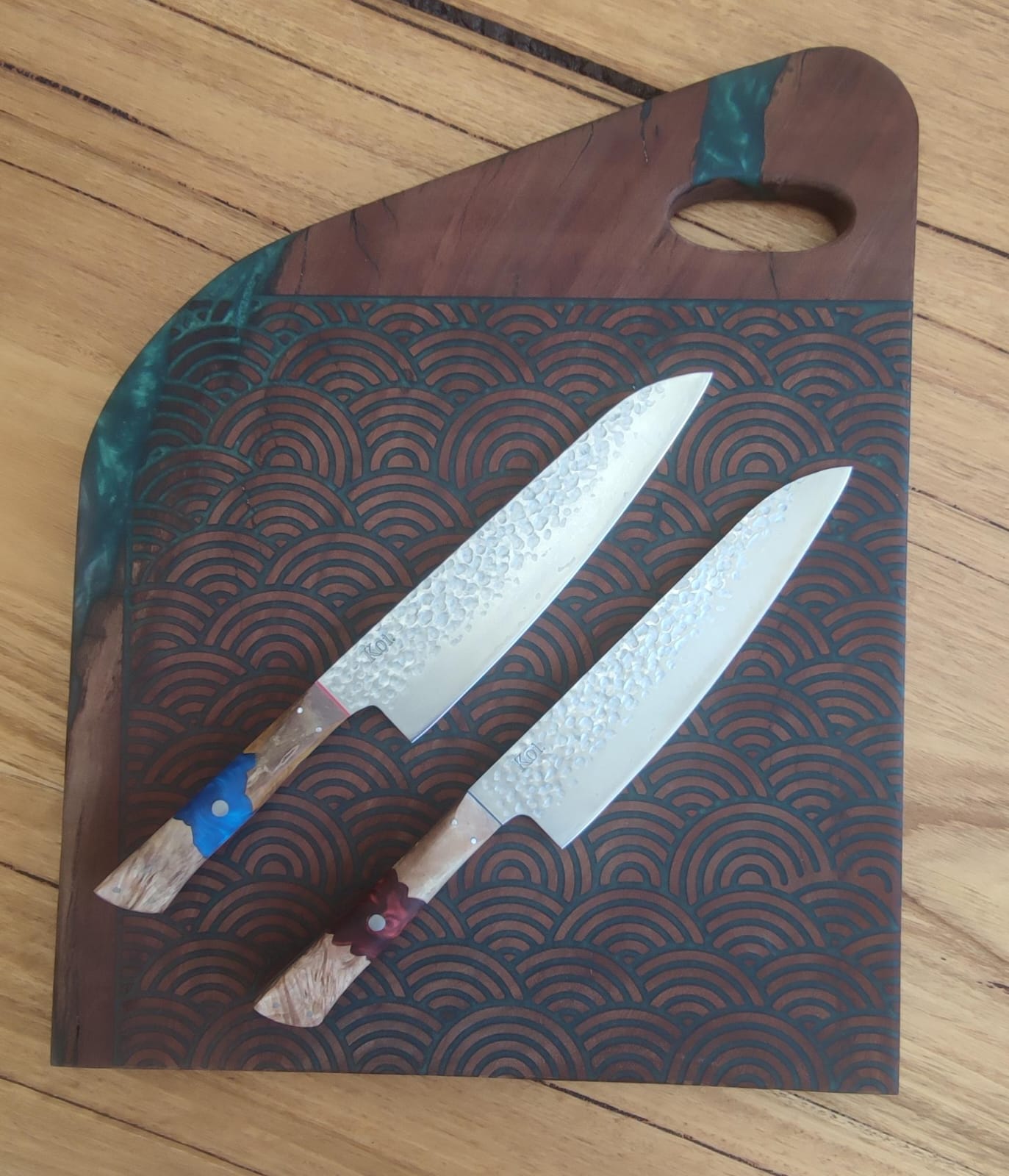Picking the right method to sharpen your knives is akin to selecting the perfect seasoning for a chef's signature dish. As knife users, the quest for the ideal method leads us to a crucial decision: whetstone or pull-through/machine sharpening. We'll explore the details of each.
Learn why precision matters, how customization plays a role, and why the legacy of quality is crucial. So, let’s dive into this world of knife care, where choosing how to sharpen is a bit like an art form, shaping the way your knives work for you.
The Precision of Whetstone Sharpening
Let's unravel the artistry of whetstone sharpening. This method involves skilfully sliding the blade across a wetted stone surface, ensuring gradual material removal for meticulous control.
Fine-Tuned Angles and Refined Edges
The standout feature? Unparalleled control over sharpening angles. Whether it's a narrow Japanese blade or a sturdier Western knife, whetstones allow exact angle adjustments. This precision contributes to a consistently refined edge, which is crucial for various cutting tasks.
Consider filleting a delicate piece of fish or crafting paper-thin vegetable slices. In these situations, precision is paramount. Whetstone sharpening stands as the artisanal approach, crafting blades with the exactitude needed for superior performance in diverse culinary scenarios.
Pull-Through/Machine Sharpening: Convenience vs. Precision
So, you've heard about pull-through and machine sharpening – the quick fixes in the world of knife maintenance. These methods offer unparalleled convenience, making them the go-to for many busy kitchens.
Overview of Pull-Through/Machine Sharpening
Pull-through and machine-sharpening systems promise a hassle-free experience. There is no need to be a seasoned sharpener; these tools boast accessibility for beginners and a time-saving advantage.
Picture this: You've got a dinner to prepare, and your favourite knife has lost its edge. Enter the pull-through sharpener – a swift solution. It's user-friendly and doesn't demand an advanced skill set. Busy chefs often appreciate the time saved in maintaining a sharp edge.
Trade-off with Precision
But, here's the rub. Convenience often comes at a cost, and in this case, it's precision. While these methods get the job done, the trade-off is in the level of control you have over the sharpening process. Achieving that finely tuned-edge might be a bit of a stretch.
Customisation: The Art of Whetstone Sharpening
Whetstone sharpening allows you to tailor each blade's edge to perfection. Imagine your knives as unique canvases and the whetstone as your brush, enabling a level of customisation unparalleled in other sharpening methods.
Whetstone sharpening provides a spectrum of grits, each contributing to a distinct edge. From coarse for reshaping to fine for polishing, the range allows meticulous customisation based on your knife's needs.
Importance of Personalised Sharpening for Different Knives
Not all knives are created equal, and neither should their edges be. A chef's knife might benefit from a more acute angle, enhancing precision, while a durable utility knife may require a sturdier edge. Whetstone sharpening lets you cater to these distinctions, ensuring your knives are honed to their full potential.
Take a chef's knife used for delicate slicing — a finely honed edge is imperative. Contrast this with a cleaver, where a more robust edge withstands heavy-duty chopping. Whetstone sharpening allows you to adapt, ensuring your knives are not just sharp but optimised for their specific tasks.
The Drawbacks of Pull-Through/Machine Sharpening
When it comes to pull-through or machine sharpening, convenience often comes at a cost. One notable drawback is the limited control over the sharpening process. These systems are designed for ease of use but may sacrifice the precision crucial for achieving a razor-sharp edge.
Impact on Blade Longevity and Edge Quality
The convenience of pull-through sharpeners might seem appealing, but it can negatively impact the longevity of your blades. The repetitive motion of the machine can generate heat, affecting the temper of the blade. Over time, this may lead to a decrease in overall blade quality and durability.
Instances of Falling Short
In scenarios where a fine, customised edge is essential, pull-through sharpening falls short. Knives with specific edge requirements, such as Japanese knives or those used for intricate tasks, demand a level of customisation that these automated systems struggle to deliver. The one-size-fits-all approach might not cater to the subtleties of different blade types.
Exploring Sharpening Tools
Understanding the tools at your disposal is pivotal in achieving the perfect edge for your knives. Let's delve into the diverse world of sharpening tools:
Types of Whetstones
Natural Whetstones
Originating from quarries, natural whetstones offer a spectrum of grit levels and unique mineral compositions, making them ideal for enthusiasts seeking a traditional touch.
Synthetic Whetstones
Crafted from man-made abrasives like aluminium oxide or silicon carbide, synthetic whetstones provide consistent grit levels, offering an excellent starting point for beginners venturing into the art of knife sharpening.
Diamond Whetstones
Embedded with diamond particles for aggressive sharpening, these whetstones are both durable and efficient. They shine when dealing with modern, harder steel knives, offering a robust solution to the evolving demands of cutlery.
Pull-Through/Machine Sharpening Methods
Ceramic Rods in Pull-Through Sharpeners
Commonly found in pull-through devices, ceramic rods excel in quick touch-ups. While convenient, they limit the level of customization you can achieve.
Manual Pull-Through Sharpeners
Featuring sharpening slots with pre-set angles, manual pull-through sharpeners are ideal for people valuing simplicity. However, the trade-off is less control over sharpening angles compared to other methods.
Electric Knife Sharpeners
Powered by motorized systems with grinding wheels, electric sharpeners offer a quick and convenient solution. Yet, precision might take a backseat when compared to the nuanced control provided by manual methods.
Conclusion
Your knives deserve the finesse of precision. Whetstone sharpening, with its meticulous angle control and personalised touch, stands unrivalled. It's not just about a sharp edge; it's about elevating your knife's performance. Embrace the artistry of whetstone sharpening; let your blades reflect the precision they're designed for.
As you delve into the world of knives, remember it's the details that make the cut. Happy sharpening!




